A 1940’s/50’s childhood in Connaught Avenue and West Street
by Gerry White
I was born in Connaught Avenue, Old Shoreham parish in 1938 and apart from the war years, lived and grew up in Old Shoreham. In 1946 the front gardens were still planted with vegetables. The big air raid shelter was in position on the green that separated the even number houses on the north side of the road from the odds on the south side. Orchard Close had not been built and the land was owned by the Worley family.
The Grammar School Gymnasium and playing fields were also on the north side where Mr Chitty was the groundsman and caretaker, he lived with his wife in a house adjacent to the school gymnasium. No 1 Connaught Avenue on the corner with Freehold Street was a shop run by Mr Stephens who was quite elderly and sold household goods and tinned foodstuffs. A bell was triggered by the front door that summoned Mr Stephens into the shop. In those days most of the houses were occupied by the original buyers having been built in the1930s.
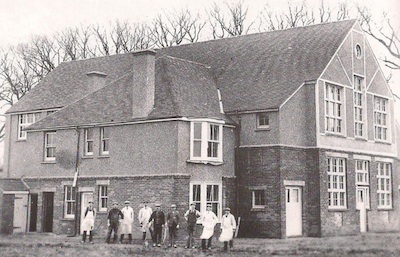
Many of the children born in Connaught Avenue, spent the first twenty or so years of their lives there. At the western end of the Avenue on the north side near Walnut Cottage there were some thatched cottages on the elbow in the road where it turns north, there were also the ruins of two thatched cottages, whose roofs had collapsed into the rooms and the whole was covered with stinging nettles. On the opposite side of the road there were a number of very old elm trees that were in a dangerous condition and in 1948 were cut down. A bungalow was later built on the land. At the extreme end of the Avenue, near to what is now the Amsterdam.
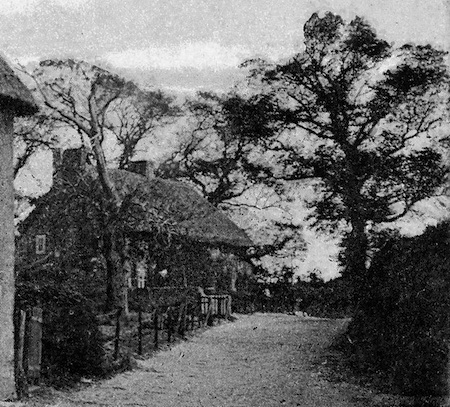
Mrs Winifred Perryman ran a little grocers shop in the thatched cottage next to the Amsterdam until about 1960 when it became an antique shop. Mr.Perryman worked for the Miles Aircraft Company at the airport and he set up a model steam railway that ran along an elevated line through his large orchard garden on the corner of Connaught Avenue opposite the old Post Office. On weekends during the Summer Mr Perryman would steam up his engine and run it to the delight of eager youngsters who looked on through the knot-holes in the fencing. This fence surrounded the old and ruined flint terrace of cottages that later became the Amsterdam.
It was about 1952 or so when the the terrace was converted into one building originally called the Blue Dolphin, the owner was a Mr Winter, before it became the Amsterdam. The row of Victorian cottages behind it were called Hoopers Cottages. The land in front of Perrymans shop was a lane with an island of grass, fenced off with chestnut fencing. This parcel of land is now the car park for the Amsterdam.
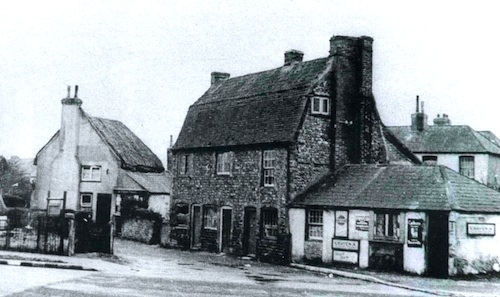
On the ground backing onto the railway line, there was a large rusty corrugated iron shed, it had been used by Mr Robins, for repairing cycles, and my father said the shed was originally used by a blacksmith. Mr Robins moved to Ham Road, and set up business as a garage opposite the Police Station, I think he was in partnership with a Mr Perkins. Most people are aware that in 1966, Dr. Beeching the Transport Minister closed many of the British Rail branch lines. One such was the Horsham to Shoreham line, a steam line. The Toll Bridge was operated by British Rail and they took a fee for crossing the bridge, the toll keeper also operated the railway gates, and the signals.
Further down Connaught Avenue near the town centre was West Street where my grandparents and uncles lived for many years from the early 20th century and consequently I spent a lot of my childhood there visiting them.
The row of houses making up numbers 23 to 41 was known for years as May Terrace and was so called, I was told, because it was built by the Shoreham ship builder William May for his employees. My grandparents and their six sons occupied 41 West Street.
Curiously the front door to 43 opened into a passage-way between 43 and 49 which gave access to two cottages that were on land between Victoria Road and West Street. These cottages later became uninhabitable, were demolished and the land was absorbed into the gardens of 49 to 61. Apparently the cottages had no running water or drainage services. They faced onto Sugden Place I think it was called and would have been 45 and 47 (hence the gap in today’s numbering of 43 and 49). My father remembered the cottages and thought they went in the 1920s.
One story in our family goes back the early 1920s. Frank Dorey had been dressed in a new sailor suit in readiness for Sunday school attendance. His mother sat him on the flint wall between the back gardens of 41 and 49. My uncle George had been attempting, unsuccessfully, to make a pond near the wall but it just became a muddy patch. He hid the mud beneath an old newspaper and said to Frank “I bet you can’t jump down onto this newspaper ” – he did, and got covered in mud. His mother, seeing the muddied clothes went barmy and started shouting at my uncle who beat a retreat out into the roadway where the threats of retribution could still be heard along the street. I was not told of the outcome.
In 1945 Frank Suter was living next door at 39. Frank had a parrot that he sometimes gave an airing by putting its cage in the back garden but when this happened I wasn’t allowed into my grandparents’ garden because the parrot, as I was later told, quite frequently used the ‘F’ word.
When the war ended a succession of servicemen returned to West Street, which was decorated with bunting hung across the road. Brown paper notices declaring ‘Welcome Home’ Bill etc were dispayed on walls outside the homes concerned. Welcome home parties were often held in St Peters Church Hall in Ship Street. Sadly some of the West Street sons and daughters didn’t return and a list of those who gave their lives are displayed inside St Georges Chapel at St Marys church.
In those early years after the war cars in the street were virtually unknown and it wasn’t unusual for residents to leave their front doors open. Retired folk sat on a chair outside their front door and chatted to neighbours and passers by. My father who lived in the street from 1913 until 1937and told me front doors were only shut to keep the cold out as theft and burglaries seldom occurred because everyone knew each other and kept a wary eye on strangers. Residents were on christian name terms with deliverymen like the milkman, postman, and bread roundsmen. Almost everyone had a daily newspaper so jobs for older children were always available to deliver the dailies, Evening Argus and, on Thursdays, the Shoreham Herald.
Like many streets in Shoreham, a number of characters resided there. Mrs Reed at number 54 had spent much of her life at sea and in the 1940s sat on a stool by her front door, she always wore a dark blue roll-necked seaman’s sweater, and she smoked a pipe.
In mid 19th century my mother’s grandfather James Nutley, was the licensee of number 5, the Builders Arms, which was subsequently occupied by the Payne family whom my mother knew. Mr and Mrs Payne had three children Ivan, Mac, and Nina, and in the immediate years after the war following the death of their parents Nina had married a Canadian soldier and they all emigrated there.
As a small boy I often visited no 5 when it was no longer a pub and there was a huge cellar where the barrel trestles still lay. In the upstairs rooms, there were a couple of bagatelle tables and a large upright music machine which for a penny played music off a very large circular metal disc. In the cellar were a number of racing cycles – Ivan, Mac, and Nina had at one time belonged to Worthing Wheelers cycling club. The house was cleared in 1948 or so and I believe Mac let the house and returned to Canada. Access to the yard was from the High Street.
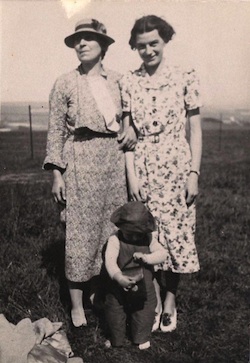
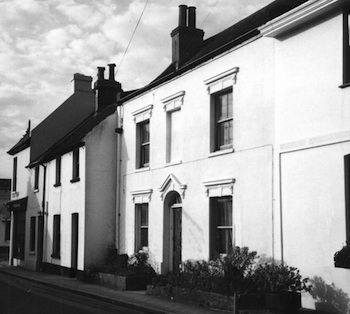
No 9a was occupied by Mr Wimble who suffered from Parkinsons disease having to be dressed and undressed by others, poor chap. He had been employed at the Shoreham Chemical Works and the family attributed the illness to him handling chemicals, the illness was never properly diagnosed. He was married to my Dad’s aunt Alice, nee Bareham. As a boy I used to visit him to run errands, usually to Lakers on Saturdays for six Herrings and 1/2 pint of winkles, then to Browns the greengrocers in the High for potatoes and veg. and ensure the change included enough pennies for the gas meter
During the 1940’s the flint faced part of the Old Dairy building was occupied by Mr Dyer, a coal merchant, who kept his horses and delivery cart there which he later replaced by a lorry. Mr Dyer’s spinster daughter lived near us in Connaught Avenue. My father said that as a young lad during early 1920s Mr Dyer would clean a cart down and especially groom a horse to take Sunday school children to Bramber for their annual outing. A ‘bun fight’ would take place in the castle grounds. I believe Mr Harker who ran Harker’s Stores in the High Street, was still using the upper part of the flint faced building to store straw that he sold for animal feeds.
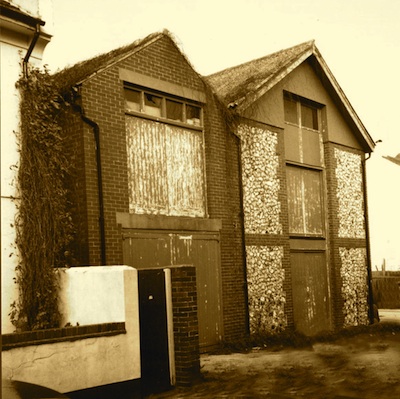
Before WW1 my father’s uncle Leonard, after whom he was named, was a milkman at the old dairy and on the outbreak of war enlisted in the 2nd Batallion of the Royal Fusiliers. His regiment was part of 38 Brigade that fought at Cape Helles on the Dardanelles in 1915 and later on the Western front. Tragically, Leonard was wounded a few days before the Armistice was signed, died on 16th Nov 1918 and is buried in Mill Lane Cemetery,
The house on the south side of the Twitten was once a shop, it was called Leazells. Mrs Leazell sold bread and a small range of tinned foods but the war years meant that there was not much to offer. She sold buns to the catholic school and milk was delivered to her shop then collected by class monitors to St Peters School across the road. She also had a large birdcage in her garden where she looked after injured birds. If any of us kids took in an injured bird we were rewarded with toffees.
When it rained we used to play with tennis balls against the curved wall of the railway bridge and the girls skipped with long ropes. In those days the only traffic in West St was pedestrian except for the odd horse and cart which was either Mr Dyer the coalman or Mr Patching with his horse Dobbin.
During the late 1940’s Sid Saunders, known as Crutchy, lived at number 7A. He had lost a leg, was a cobbler, and repaired shoes at home. He had a pet duck, which accompanied him for his daily lunchtime pinta in the Bridge Hotel. Also one house maybe no 11, was occupied by Mr Mitchell, who was chauffer for Mr White of Whites Timber Co. The only car parked in the street in those days was Mr White’s expensive Rover, a very smart and highly polished beige coloured motor.
20 & 22 West Street was originally a Methodist Chapel but from1945 it was used for something of a less than divine purpose (dependent on your point of view) when it became a factory for by Durex Ltd. Eric Long a local man was employed as a ‘test pilot’ – he released a blast of air into the sheaths to test their elasticity and soundness. The building was used from the mid 1950s as a boys club, and latterly as a snooker club.
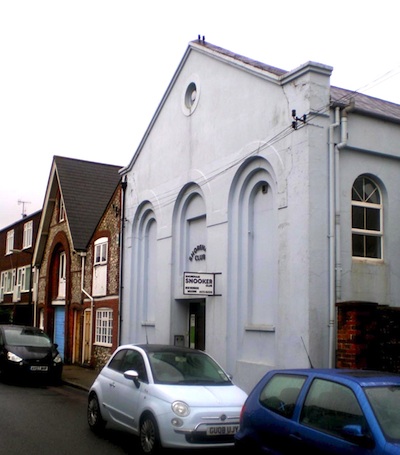
I can remember that the Thorpe family lived at number 9, one of the flint-faced cottages. In 1945 I attended St Peters Roman Catholic School in West Street with Michael Thorpe. Some of those cottages had a stairway down to a cellar, just on the left inside the front door.
1n 1945 number 34 was occupied by Rose Offord, she regularly called at 41 to visit my grandmother to have her ‘tea leaves ‘read. No 44 is where the Ellis family lived I attended St Peters RC School with June Ellis also went to the nearby catholic school and her brother John went on to be a superintendent for the Southdown Bus Company in Brighton.
In the 1940s the old barn on the corner with North Street had the stable doors facing into West Street, directly under the wooden beam. There was no entrance on the North Street side. It only housed one horse which in my time was called ‘Dobbin’ On Saturday afternoons I used earn sixpence cleaning the stable, polishing the harness and running errands for the owner Mr Patching who had the ironmongery store on the corner with the High Street.
The delivery cart was put into the back of the stable with much clanking of tins and various hardware goods that festooned the rear of the cart. I seem to remember that the roof of the building was covered with rusty corrugated iron sheeting and a pedestrian door within the main stable doors which facilitated access for Mr Patching without having to open the larger doors. For many years Mr Patching sponsored a road running race for teenagers in the town. It started in Mill Lane, then to Buckingham Road ending up at the finish line on the Upper Shoreham Road near Oxen Avenue where cup was presented to the winner.
The school in West Street here was the Roman Catholic St Peters school where children attended from primary to school leaving age, then 15. The gap in the wall is where a wrought iron gate hung giving access to the playground. The teaching staff were headed by Sister Aloysius Clarke, with Sisters of Mercy, Paul, Baptist, and Mary Mercy who were ably assisted by Miss Sirett, Miss Haggerty and the only male Mr Hilton. I have very happy memories of my years at St Peters, despite primitive toilet facilities that had just one toilet to flush three traps. The school badge was St Peter’s crossed keys. Discipline was strict but not severe and despite the occasional pupil caning that occurred it was for me a happy and pleasant learning atmosphere. The Convent for the holy Sisters and some boarders, was between the school and the railway line.
Returning to Old Shoreham – in 1947 up near the Red Lion two houseboats were berthed either side of the Toll Bridge and on the north side the boat was the home of the Rothwell family. The rear of the boat faced towards the Steyning Road. It had been a ships lifeboat, or at least that is what Robin Rothwell who lived there with his parents and three sisters told me. It was about 40 feet long and firmly moored into a deep channel that had been dug out of the riverbank. The boat had no electricity and water was supplied from a hosepipe laid across the railway line and under the rails from the house on the other side. Robin told me that they illuminated the boat by oil lamp.
On the south side of the bridge, Mr Northeast had a houseboat that appeared to have been a barge where he lived alone. In about 1949, the Duke of Norfolk’s Estate office told the houseboat owners to move off from his land and the boats were moved to about five hundred yards north of the Bridge and Mr Northeast berthed in a creek by Cuckoos Corner. in the early 1950s, the Rothwell family were eventually housed in Shoreham.

At the bottom of The Street there was a farm, the farmer was Mr Frampton who had a florid complexion and I remember he wore knee length gaiters. There was a large wooden barn that was set east/west opposite the farmhouse and farmyard. The barn sat alongside a big lambing field. In Springtime Mr Frampton brought his ewes into the barn for lambing and locals made something of a pilgrimage to visit the lambing field to see the newborn lambs.
The milking parlour was on the East side of The Street next to the farmhouse. The yard had been cemented over to make it easier to wash it down and keep reasonably clean. The dairy herd was grazed in a field opposite Adur Lodge at the top of The Street. I believe the Ellman Browns lived in the Lodge, the former home of Squire Colvill Bridger. A big house at Lesser Foxholes was owned by John Rawlings and his wife who owned the Sussex Shipbuilding Company on Shoreham Beach, they carried out repairs and built Naval craft. I believe he had also been the Commodore of the Sussex Yacht club. I knew his gardener Freddie Tester who, like my Mother came from Portslade. Fred’s sister Ivy married a Shoreham man Mr Priest, and they lived in a house in The Street.
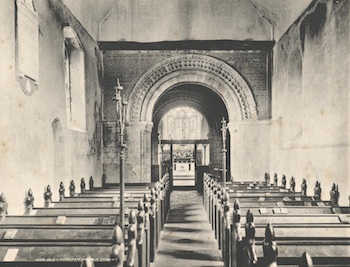
The Old Shoreham Church of St Nicholas, has its roots in antiquity. In those days after the war, the Rev Percy Shelley was the vicar and he held a Sunday School in the church. I recall helping my cousin David, with pumping the organ, which was done by hand. The church always had a damp smell and it was as cold as charity. Old Shoreham in 1948 was very rural and was out of time step with New Shoreham. It was easy to distinguish between the two.
Some of the children I remember in Connaught Avenue and the Old Shoreham Road were Tim Mahoney who lived on Commercial Terrace next to the Swiss Cottage pub. Anthony Payne of Freehold Street – his father lost a leg in the war and earned a living repairing shoes from home, John Lyne joined the Merchant Navy and became a Master Mariner; Malcolm and Graham Snelling whose parents ran the butchers’ shop in the High Street; Barry Hamilton whose nickname was “Spanner” his dad was Jock Hamilton who had a garage on Victoria Terrace, Brian, Eileen and Rosemary Parsons – Mr Parsons worked at Power Station; brothers Robert, Ronald, Royston, Roderick, Roland, and Roger Riggs – although Roy was a submariner in the Royal Navy for a while most of the brothers (and eventually Roy) entered various aspects of the building trade and are still well known working in Shoreham.
Phillip Sirrett also joined the Royal Navy as a lad and completed a full career there as did Keith Sharp of Colvill Avenue; a crippled lad called Michael Humpreys who propelled himself in a wheelchair that had a hand turned pedal cylcle chain that turned the front wheel; Burstow was a builder; Funnel’s Dad was the High Street furnisher; John Landale was a lifeboatman for many years. Colin Ulph became a town councilor at quite a young age; John Lyne joined the Merchant Navy and became a Master Mariner. As for me, when Dad was called up Mum took me to Fishersgate where we were bombed out, evacuated to Hamilton then on D day came back to Shoreham – initially to West Street then on to Connaught Avenue. I was called up for national service but stayed in RAF for 23 years at home and overseas. (other children’s names that Gerry recalls are listed at the end of this story)
Some Children were not given the freedom to roam but many were. We had the Downs, river, brooks and beach to play on. The seasons tended to dictate what we did. During summer months children went pritching flatfish (using a stick with a nail on the end to impale the fish) in the Adur especially at low tide and at high tide fished off the Toll bridge. In late summer, blackberries could be picked on the furze on Truliegh Hill and violets on Erringham Shaw along the Steyning Road. In springtime many local children had a small collection of birds eggs, not allowed now of course.
Picking wild flowers at Coombes and Small dole. Making a cart was fun – a box was usually put on a set of old pram wheels with a moving axle that could be steered. We could set off on a cart, which would zoom down Mill Hill then Erringham Road. One of us would be stationed at the top of Mill Lane watch for traffic and if nothing was coming the cart would continue down Mill Lane to Victoria Road. The speed and vibration often caused the cart to break up and the heels of shoes quickly wore out.
We hunted for frog spawn, minnows and newts in Meads Meadow and the Brooks along the Steyning road. On the Downs, in long grass, in summer a kick would raise a whole host of Burnet moths and little blue butterflies that are not now seen in such large numbers. The game of ‘I Spy’ helped to increase our knowledge of nature and bird names. Seeing Mr. Frampton’s combine harvester and threshing machine always caught the imagination as it cut, threshed, and bound the straw keeping the grain as if by magic.
The Norfolk Cinema, later named the Ritz, had a Saturday morning film show, when popular cowboy and other films were shown. There was often a serial that usually stopped at a critical time in the action to encourage us to return the following week to find out what happened. As the cinema emptied after each performance some would run up the road shouting “I want to be Roy Rogers” (or Hopalong Cassidy etc.,), slapping their backsides, to simulate riding a horse.
The excitement of the films though would soon be forgotten when we returned home to be brought down to earth with shopping chores, to Worrals for heavy spuds, cabbages and garden peas – the money for Saturday flicks had to be earned.
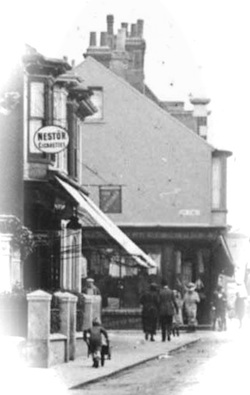
In winter the Brooks and Swiss Gardens Lake sometimes froze over when it was possible to skate there. Early in the winter of 1947 we, awoke to find a 3ft snow drift against the front door of the house which faced north. My Father was unable to travel to his place of work at Crawley despite struggling to get to the railway station, to find that no trains were running. Our next door neighbour’s daughter Hazel Norris and I managed to get to our school even though the snow was over our wellington boots. However, Miss Haggerty, our teacher at St Peters RC School was waiting to tell us to return home. We were pleased to be excused school but Hazel and I were were somewhat miffed at having to return home. “No making snowballs but go straight home” Miss Haggerty said. Our little school was frozen out and as the days progressed further into winter so more snow fell and the ground froze.
Work for my father at Crawley was impossible as the sand had frozen, house construction stopped, plumbers, bricklayers and all the workers were sent home. I think that all work at Crawley was held up for three weeks…an almost unheard of period of time. The dole queues that winter were long.
I remember at the Swiss Gardens the manager, Mr Bond, opened the gate on Freehold Street and crowds of people skated on the lake. Mr Bond kept his pet Alsatian dog on a short lead whilst so many folk were in the grounds. I think the ice was at least one foot thick of ice and supported the weight of many people ,… It remained so for about 10 days before a loud screeching noise from the ice told us it was melting. Apart from the winter of 2010 I don’t ever remember so much snow.
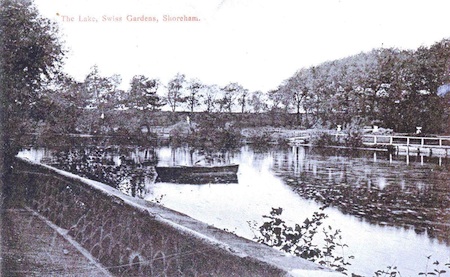
The most significant change to Old Shoreham of course has been the loss of farmland and the construction of dwelling houses. The closure of two farms, Old Shoreham and Little Buckingham owned by Mr Frampton, and Mr Nye have both gone. Obviously the value of housing showed a better profit than the continual hard toil on the land.
Even the allotments, on the South side of the once Old Shoreham School, were given over to the construction of St Nicholas Court. The garage at the eastern end of St Nicholas Lane was sold to provide more building land. The Grammar School gymnasium and playing fields now lie under the Greenacres housing estate. The grammar school moved to Kingston Lane and took over what had been another private school called Caius School, pronounced ‘Keys.’ The thatched cottages in The Street and the top of Connaught Avenue however have managed to survive and now command good prices.
Above Old Shoreham stands Mill Hill now savagely sliced through by the A27 Shoreham by-pass. Despite that the view of the Adur Valley from there is still well worth the climb.
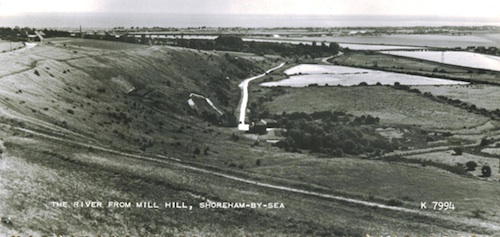
A nineteenth century Vicar
A mighty vision he
To build a splendid chapel
That is seen from out to sea
It stands above the Adur
That flows from out the land
From Mill Hill the sight is still
Panoramic perfection
Nature’s picture, a silver sea
The Airport and bridges one two three
That carry traffic east to west
And then the other way
Shoreham folk and visitors
Completely all agree
The view from here is marvellous
The best there is to see.
Gerald White
March 2012
Edited by Roger Bateman
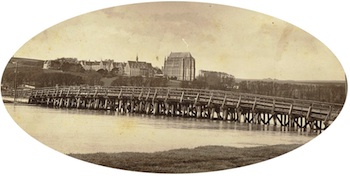
Other children’s names recalled:- Terry Wells; Sonia Sharp; David and Joyce Ellams; Jennifer, John, and Peter Landale; Helen Samson; Robin and Mary Rothwell; Harry James; Stephen Hambrook; John Horton; Jean Bird; Peter, Teddy, and Wendy Weller; Joy Shepherd; Rohna Cotman; Brian Booker; Joyce O Connor and brother Donald; George Andrews; Anthony Gilbert; Pauline Tate; Sylvia Gammans; Keith and Sonia Sharp; Brian Burstow; David White; John Kennard and Kenneth Hambrook; Brian Firth; Brian Winter; Anita Thomas; Sylvia Bettridge; Hazel and Kevyn Norris; Anthony, Margaret, Christopher, and Peter White; Michael Beeler; Pauline, Venita, and Graham Hedger; Connie Munnery; The name Richard or Dick Hall also comes to mind as do the surnames of Kimber & Carpenter.



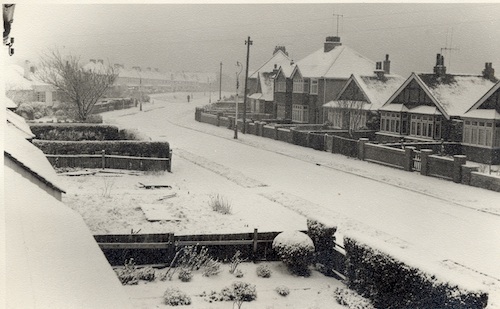
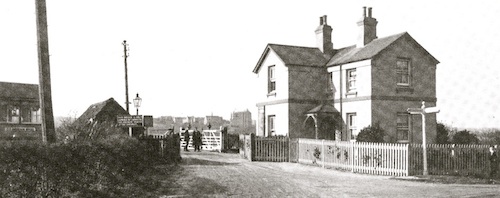
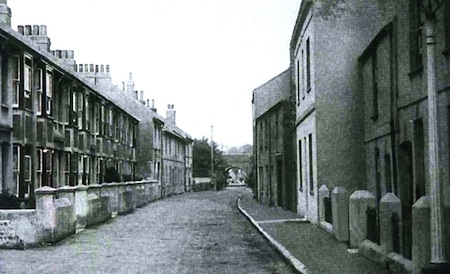
is Ron and Roland Rigg still in shoreham
I think all the Rigg brothers still live in Shoreham but sadly Ron passed away some years ago.
I am the sister of Antony Payne , it was nice to read ref to my brother and my Dad, I only went to St Peters for a couple of years but well remember the nuns and Miss Sirrit and Haggerty
My mum, Ruth (born 1936) was a boarder at the convent near St. Peters school and remembers the names Isobel Shnomski, Jennifer (Edwards?), Joyce Enever and a boy called Laurie who lived opposite the school. Does anybody know what became of any of them?
My mum, Maureen (Molly) Sumner (born 1933), and her brother and sister (Den and Sheila) grew up living opposite the school on West Street. They used to live next door to the Roberts family (Her best friend was Pauline Roberts). She loved reading these memories.
You have just relived my childhood. Lived on Old Shoreham Road, played in the burnt down cottages on Connaught Avenue, along with the Lawrence’s, Snelling’s and Ansells. It was almost as though I had written my own memoirs. Thank you.
It is very pleasing to get some feedback about my Memories of Old Shoreham , sometimes my Grey matter plays tricks, so thanks for replying.
Sometimes it is just the smallest fragment of information: a name, a place, a fuzzy photograph that can trigger memories from way back. Thanks Gerry.
Hi Gerald. I am trying to find out information, for a little history project, on the original Longcroft in Southdown Road. I lived there for 2-3 years late 60’s into the 70’s when it was converted into flats. In 1973 we were turfed out and Greens the developers raized it to the ground in 1974 and built the flats that now stand there. I have found out that the original Longcroft was built for the local ’eminent’ shipbuilder James B Bailey (who owned the pleasure gardens Swiss Cottage) . I understand it was, in it’s lifetime, a market garden, a doctor’s house, a girl’s school, and housed the Canadians during the war. Also, did the Loader family own it just before it was demolished. Information is very sketchy and if anyone else can help that would be great. Thanks, Ros Hamblett
I remember it as being called Queens school , it was a girls school, that was in the early 1950s
really don’t know much about the building, other than that described by you..Good luck with your inquiries Gerald
Thank you Gerald. I have absolutely loved reading your memoirs. I did leave another message on a previous post. I wasn’t born until 1951 so I’m 13 years younger than you but I was born in Southlands hospital to Eileen and Arthur Sparks who lived with Eileen’s mother and father the Greens of 15 West Street. I’m unsure of the exact year but we then moved to your Grandmother’s old house, 41 West Street where my sister was born and then my brother when I was eight. Not long after that we moved to Mill Lane. You referred to my uncle (in law) Mr Albert Mitchell who lived at 13 West Street. I remember him not when he was a chauffeur but after when he was caretaker of The Snooker hall opposite and I used to earn a few pennies for dusting. My overwhelming memory though is of the smell of beer in there and the sense of how grown up it all was to me aged 7! Albert and Queen (our name for her) Mitchell tragically lost a daughter to measles around 1927 aged 3years. My mother, also aged 3, had it at the same time, living next door at no15 but thankfully survived. A stark reminder of how lucky we are now to live in this modern world of medicine no matter our sometimes gripes at NHS waiting times! I can still picture my bedroom at no 41 and how cold it was! X
Well I am blessed, my nan , Ellen White passed away about 1951 she had bowell cancer, my grandad William White went to live with my Dads brother Chris in Connauaght and gave up tenacy of 41 West Street , he couldn’t manage on his own . By the way, are you related to Pauline nee Mitchell. I slept in that bedroom at the front of the house, and yes it was as cold as charity…
Yes Pauline was the granddaughter of the Mitchell’s that lived at no13 West Street. I lost contact a long time ago. I live in Bucks now but still have a brother in Windlesham Road and a sister in Buckingham Road so I’m down reasonably often.
I remember seeing your father up a ladder painting … noting unique about that … except for I think he was in his late 80’s! Your brother is heading the same way too!
Hi Gerald,do you have any photos of the old MOD Nissan huts at the bottom of Eastern ave?
I was in the Air Cadets in 60s. We had a girl in the GVC, (girls venture corps) her name was Pauline Mitchell, married Mike Jeffries about 1972..probably not the same Pauline, though. She lived on corner Gordon road and eastern. If you could email any link to old photos of the nissan huts as viewed from Eastern ave, then great… kind reg, Phil
Sorry no photos of the T A centre in Eastern Avenue where 1440 ATC met..
Oh Gerald, in my dotage (80 in Occtober 2024) I had just been trawling through the Internet looking to see if I might find some old friends of my boyhood years in Shoreham. And brother, did you just!
We left 172 Old Shoreham Road in 1950/51 to What you might call New Shoreham. A brand new council house at 10 Williams road. I’m afraid my little grey cells are nothing like as sharp as yours but the pictures that your words paint have taken me right back to those early post war days of Old Shoreham. What a wonderful life for an adventurous boy with, as you say, the river, the downs, the airport, the sea, the Meades, Brook and Princess Elizabeth waving to us on her way to Lancing College.
I have never forgotten though some of the names that you have reminisced over. The shopkeepers and tradespeople that were the heart of the town, many to this day. I was delighted to see the response of Wndy Mercer. Neil was my best friend with whom I led into many scrapes that I’m happy to admit to. Such as scoffing all grapes in his neighbours greenhouse. Talking of green, I have pondered all my life as to how they (as I was told) painted his throat green due to a medical conditional that I think was diabetes. And yes Wendy I still like my Marmite laid on thick!
As for West Street, I enjoyed many years, twice a week at the SSBAC and if I do say, along with Peter Brown and others we achieved fame by appearing on the television and performing at Wembly Stadium. I must also mention Michael Humphreys. I used to like spending time with Michael, it was a delight to see his joy when I presented him with a furry caterpillar.
Thank you, thank you Gerald. I am happy to say that I have walked in your footsteps for a part of my life that still lives with me, as it does for all those that you have shared your life with.
Best wishes
Michael Kent (nee Juden. Mum remarried)
When the shop on Upper Shoreham across the road from St Nicholas Lane was built was it first a Grocers Shop? It later became a garden shop but I understand it was originally built as a shop. After the garden shop it became a house maybe for the first time.
My fathers Brother Ernest White rented it just after the place was built It had been built as a shop circa 1933 .
Thanks for the info. Someone said it was a bungalow first!
The garden shop at 417 Upper Shoreham Road was previously a grocery shop called Adur Stores. It was run by Connie & George Harrison who lived there with their daughters, Keren & Christine. George Harrison used to deliver groceries in his green van; if a customer was out, he would open their back door and leave the box of groceries in the kitchen for them. Hard to imagine that now. The Harrisons were friends of my family and my mother sometimes helped out in the shop. I remember, as a child, helping to weigh out sugar and rice into the customary blue paper bags. The Harrison family moved to Lancing in about 1960 and opened a grocery shop in Freshbrook Road.
Lots of familiar Shoreham names in the article and at the end, two I knew, Peter Landale and Terry Wells, who both played football for Shoreham United.
Peter’s nickname was ‘Nipper’ and Terry Wells was one of three brothers. Brother Brian was also a footballer who played for Lancing when I was a young reporter for the Worthing Gazette and Herald; Bernie was a senior policeman with Sussex Police.
The reference to hunting for frog spawn, minnows and newts took me right back. In the ‘60s, before the Adur flyover was built, I used to go collecting newts and frog spawn in the brooks along the Steyning Road with my schoolfriend David Williams, whose family lived in Mill Lane.
We used to fashion a net out of an old stocking end wrapped round a bent metal coathanger poked into the end of a bamboo cane. Our catches were put in an empty jam jar filled with stream water and carried with a handle made from string tied round the lip of the jar.
The cottages you talk about at the northern end of Connaught Avenue and the ones next to the Amsterdam have a special resonance to me.
My grandad (Fred Gilbert) lived in one of the cottages (which is still there) on the eastern side of what is now the Amsterdam. It was a short trip to his work at Ricardo / Bridge Works on the other side of the river. And his dad, George, was the head gardener at Lancing College, obviously quite close by too.
My nan (Dolly) came down from Streatham and stayed in one of the cottages at the north end of Connaught Avenue and, I think I am right in saying, it was during her stay that she met Fred.
After they were married, they lived in Addison Square, Lancing, but later moved back to Shoreham, to Freehold Street.
My dad’s mum (Hilda) and dad (Alf) lived in a humbler dwelling along a passageway round the corner from Freehold Street, in a row of houses known as Aston Cottages. Hilda worked part-time as a cleaner at the Swiss Cottage.
My dad’s dad died in 1965 while they were still at Aston Cottages. It can’t have been long after when the council decided to flatten Freehold Street and Aston Cottages and redevelop the site with flats. My grandparents were rehoused at White Lion Court in Ship Street.
Thank you for that Nick – all now part of the history of those times!
Fascinating article, many memories of names and places. I didn’t get a mention, so I clearly didn’t make my mark in Old Shoreham! I’m sure I’ll re-read it it many times. Other names – Christopher Hobbs, John Beddis, Phyllis Howell, Maureen Morris, Margaret Summers, my cousin John Harden, and more will come to mind. Many thanks for making this available.
Thanks for those names Michael, I’m sure they will prompt recollections from others that recognise them. You may not have been mentioned then but you’re one of the few that recall and record names from those times and in doing so get a mention now!
I was born in Southlands hospital January 1955 and lived in shoreham until 1978. I and my elder sister went to St Nicholas school where our first teacher was Mrs Woolgar, the headmaster was Mr Cullen- administered my first canning for throwing snowballs! Children played in the old farm buildings by the planning field much to farmer Framptons displeasure. Conkers were taken from the chestnuts of Lesser Foxholes where the gardner was a Mr Tester – poor man had to clear up the mess made by throwing sticks at the branches to get the conkers. I remember there was a scout hut in St Nicholas lane and 2 air raid shelters in the school playground. Goodness what memories this article has triggered…thank you!!
Spelling error – that should be lambing field. No predictive text in Mrs Woolgars class!
We moved to Shoreham in 1955/56 I was two I went to Victoria Road school in 1959 , we lived at 16 crown road until we moved in 1963 to the Forest of Dean, I often what happened to my friends of those years good memories.
John do you remember the plane crash at shoreham in the early sixties, I think it was at the end off Buckingham Road, I might be wrong about this location.
I was at Buckingham Road school when a Tiger Moth crashed in a house on the west side of Buckingham Road. Unfortunately 2 men lost their lives.
it was good to reading so many names and places of my early childhood. I was born at no 10 the court< ship st. 1947 . aurther sparks gave me my 1st job via my dad jock weild. and help decorating 41 westst when aurther moved mill lane.shoreham athletic club was 1st in st peter hall. mr and mrs parson ran it.early 1960s play football shoreham boys club in west st next to mrs smiths hou se no11 I think tues and thurs training nights upstair s must have driven her crazy.
My Nan was Mrs Smith from number 11 West street.people knew her as “Doddy”.. Her real Christian name was Elsie and her maiden name was Ellis. My grandad was Tom Smith and they had 3 boys Robin,Peter and Paul.My grandmother Daisy Harding ( nanny Dodds mum) lived at I think number 76 west street with her sister Gladys Ellis.. the story goes that my granny Daisy
( ne Ellis) married Syd Harding they had 2 children my nanny Dodd and Sonny. Gran was a cleaner at the Hebe and Syd was a builder for I think Cooks…Anyway Syd done a runner with the blokes wages and my Gran was left with 2 young children, she got more cleaning jobs to pay all the blokes wages back that he had stolen.Syd was never found ,despite his cap and bike were found down by the river…( rumour had it it was a fake suicide)
My Gran put an add in the missing persons column in a national newspaper!.. fascinating stuff.How much of it is true I’m not sure.
Loved reading all your memoirs of growing up in shoreham.
Your poor Gran, Debbie, but what a resolute and resourceful character. Maybe someone can find out more of the story eventually.
I knew Doddy Smith, and went to school with Robin Peter and Paul at St Peters RC School in West Street …
I was born in 1938 at Southlands .I remember so many of the places and people,my name was Cotman, I lived for a while in Connaught Ave with my aunt and uncle, Auntie Win nee Perriman had the shop at the top of the road I remember the train that ran around the garden though in my time it was in a big she’d as Mr and Mrs Perriman were very old. The shop on the corner opposite the Swiss Gardens (2 doors ) away used to make Ice loollies made in an ice tray from orange squash ,best lollies ever. I learned to row on the lake. After the war we used to walk over to the beach though the area that had been flattened in case of invasion,we loved to play in what had been people’s gardens.
Thank you to everyone who made comments on my Memories of Shoreham by sea. Roger Bateman who edited the Screed…did a good job!!
Great to have been able to save your memories on SBS Gerry and for other people’s memories too that they prompted!
Amazing memories! Thank you so much….
I went to the Old Shoreham School, St Nicholas from around 1948. Every Wednesday Morning we went to St Nicholas Church for a Service, and yes it was cold and damp! In the afternoon we went for a ‘Nature Walk’ up on Mill Hill. I remember the air raid shelters in the playground…very creepy.
Did you belong to the Air Training Corp that had its headquarters on the airfield? I was in the Women’s Junior Air Corp and we used to share the same headquarters.
I remember you Sandra you trained as a nurse and was in the WJAC with Miss !Butler as the CO..where have the yrs gone . Brest wishes to you I live in Lincoln.
Does anyone have a picture of the norfolk cafe that was up near the Conservative club when the arundel Arms was about 2940s 1950s times thank you
Anyone have old photos of 3 Ham Road from 1913 please. Near Shoreham by sea train station. Tracing my family tree. Thank you
Hi Gerald, my memories of Shoreham by sea were from the 1960s, when as a child we frequently drove through Shoreham along the High street passing two pubs. I remember the first well with a pirate outside and I have found a photo of the Crown and Anchor. I believe it’s been replaced by a plastic copy of the pirate now. If my memory serves me rightly the second pub was on the opposite side of the road and had the bust of a woman outside. Do you by any chance know the name? Thanks
Hello,
Do you happen to gave any photos if the small woods at the end if Eastern Avenue from the 1960s? They were opposite the Green Jacket pub.
Sorry Christine we have no photos of those woods on this website
My cousin was born at Windlesham Nursing home, Shoreham in June 1946. I worked at Shoreham Airport for 10 years but was never aware of it. I guess the nursing home no longer exists. Do you know where it was please?
Many thanks
Perhaps the Windlesham Nursing Home on the south side of Windlesham Road David (1940 street directory on this website)
The directories suggest the Home was just west of the junction with Windlesham Gardens.
Thankyou very much Roger.
David
Is anyone reading this who was a pupil at Cauis School Kingston Lane in the 1950’s. As a former Pupil myself I would like to discuss this that period. Thanks Mike
Does anyone remember who the chairman of shoreham was during the war years? He doesn’t seem to be mentioned anywhere.
According to the 1940 Kelly’s directory David, the chairman of Shoreham UDC was Sidney John Williams JP
My husband used to live on the beach in one of the railway carriage bungalowscalled tollemarche he went to scool at caius school now shoreham college,if the tide was right he would cycle down to the old fort to meet his friend anthony warre dymond,and they would whistle to the rowing boat ferry which would take them over to the lighthouse with their bikes for 1 penny each otherwise it was a walk over the footbridge and the bus,or if fine they cycledto school,later he moved to oxfoed lodge southdown road and woud cycle to school across the allotments now nicholson drive.
Oh yes, my great-uncle was Fred Tester. His sister Ivy was my grandmother. She lived in Cherrydene, The Street from 1938 until her passing at the ripe old age of 95. She lived there first with my grandfather Joe (Wallace) Bradford until his passing in 1976. After that, she used to go down the community centre every week to play cards. That was how she met retired baker Bernard Priest who became her 2nd husband and whom she also out-lived.